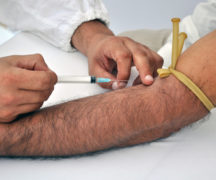By JAN LARSON McLAUGHLIN
BG Independent News
Travis Williams knows that without Vivitrol, opiate addicts who just went through detox are likely to start using again as soon as their buddies pick them up at jail.
“They overdose before they ever leave the parking lot,” Williams said.
But he also knows that using Vivitrol can take away the cravings and the highs that cause many opiate addicts to relapse an average of seven times.
“You might as well take a tic-tac,” since it will provide the same high as opiates do while on Vivitrol, Williams said during a meeting last week in Wood County about recovering from opiates. Attending the meeting were those who deal with the local addicts in the courts, law enforcement, public health and social services.
In June of 2016, Vivitrol shots were started in Wood County Justice Center for opiate addicts who want to quit. Since then, 34 inmates have received their first shots in jail, which were then followed up with monthly shots and counseling on the outside.
Northwest Community Corrections Center has a similar program.
“We are working on a definition of success, but as of June of 2017 we have 21 people who we feel are still compliant with the program,” said Doug Cubberley, chief probation officer and court administrator at Bowling Green Municipal Court. “Only two people have gone out and reoffended by committing new crimes.”
Cubberley remembers the day a man came to his court probation office begging to go to jail.
“We had one young man come to our office who said, ‘If I don’t go to jail, I’m going to die.’” The man was addicted to opiates and knew it was only a matter of time till he overdosed, Cubberley said last year.
Probation workers in Wood County began noticing in 2014 that something was killing their clients. “They were dying at alarming rates,” Cubberley said. So the conversation started about opiates and their growing grasp on people of all ages and backgrounds.
“We all wanted to think it was only in Cleveland or Toledo,” he said. But it was clearly here, too.
So leaders in the police, court and drug treatment professions started looking for a solution. Community meetings on the opiate epidemic were held in Bowling Green, Perrysburg and North Baltimore.
Statistics show the highest rate of accidental overdose occurs when an addict leaves jail or a treatment program, Cubberley said. “Once they are in jail, they lose tolerance to opiates.” And that often leads to deadly results.
So Project Direct Link is intended to offer opiate addicts a different course. The program gives inmates an injection of Vivitrol, a drug that helps prevent cravings and doesn’t allow them to feel the positive effects of opiates.
The injection lasts 28 days, which gives the person a “safety net” until they are linked up with treatment programs.

Travis Williams talks about Vivitrol use for inmates trying to kick opiates.
Williams, of Alkermes Inc., covers his company’s Vivitrol programs in Ohio, Kentucky Tennessee, Virginia and West Virginia.
“I’m in the hotbed of addictions,” he said last week.
Williams is not a reformed opiate addict, so he can’t speak from the seat of those using Vivitrol. However, he can speak for the family members who watch addicts destroy their lives and the lives of those who love them.
“I do know what the kids go through,” Williams said. His dad was a well-known and respected banker and school board member in the community where Williams was raised in Tennessee. Though the community turned a blind eye, his dad was an alcoholic.
“At the time, I didn’t understand addiction. I thought it was a choice.”
Williams’ dad missed most of his basketball games, including the game when his son made the game-winning shot.
“If I tell you I hate addiction, that’s an understatement,” Williams said. To him addiction is the mess is makes of children’s lives. “I see the little boy looking up in the stands to see his dad,” who wasn’t there again.
Years later, in his job with Vivitrol, Williams is trying to give a real chance to opiate addicts – who make up an estimated 70 percent of the U.S. criminal justice system.
“Guys, we’re not going to be able to arrest our way out of this,” he said.
The relapse rate for released inmates is 80 to 85 percent.
“We can’t just keep punishing them. We need to treat them,” Williams said. “It’s a disease.”
Granted, the first time a person uses opiates, it is a choice, but is only takes a few times, “and it’s the point of no return,” he said.
Ohio was one of the leaders in using Vivitrol programs while inmates are in jail, so they no longer crave the drug and no longer get high from using it. Now there are 450 Vivitrol programs in 38 states. Without Vivitrol, the craving for more opiates is two to three times more powerful than for sex, and much greater than the drive to eat after starving for seven days, Williams said.
Many opiate addicts don’t remember waking up in the morning and not needing a fix. “They don’t remember what it’s like to function as a non-addict.”
The Vivitrol shots are given to addicts at a particularly vulnerable time, since without the shots, they are much more susceptible to overdosing upon being released from jail.
“The No. 1 reason for relapse is cravings,” Williams said.
The Vivitrol injections are continued monthly, and are combined with therapy. “Otherwise, it’s like putting a Band-Aid on a gaping wound,” he said.
Cubberley is hopeful that the Vivitrol program will continue to help jump start real recovery for opiate addicts.
“It is an ongoing collaboration of many agencies and three courts (Bowling Green Municipal Court, Perrysburg Municipal Court, and the Wood County Common Pleas Court) that seems to be making a difference in our community,” he said. “We are continuing to monitor the data with the hope that the present trend continues.”





